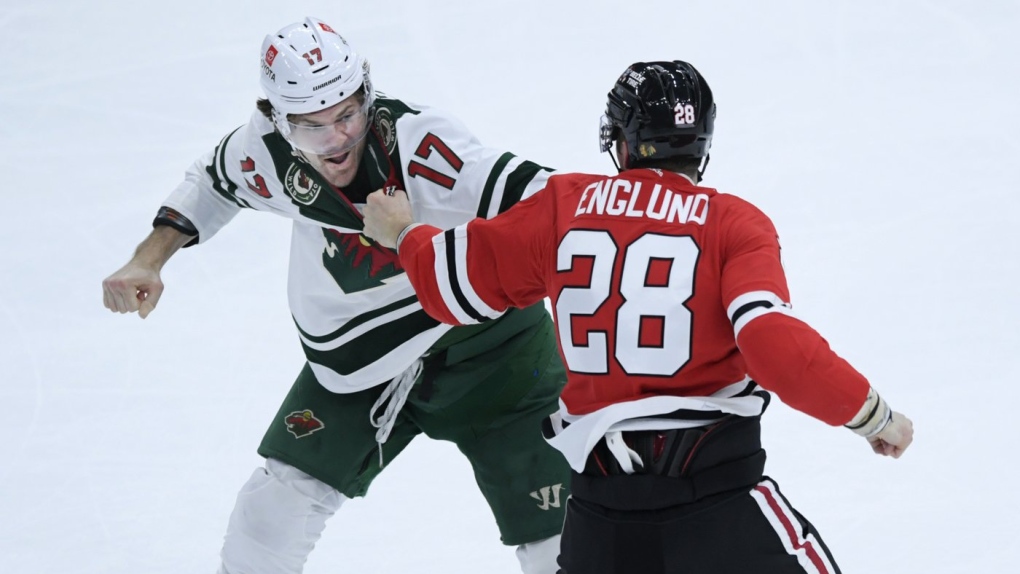NHL tough guys die 10 years younger than their fellow players, study finds
MONTREAL –
A study of former National Hockey League players shows that enforcers who spent a lot of time dropping their gloves or in the penalty box lived significantly shorter lives than their peers.
Researchers at Columbia University in New York reached the conclusion after analyzing data from 6,039 NHL players from 1967 to last spring.
The study, published Wednesday in the JAMA Network Open, found that enforcers died on average a decade younger than comparable peers who were drafted at the same rank, were of similar height and weight and played the same position.
The researchers did not find more deaths among the NHL enforcers than in the control group. “However, being an enforcer was associated with dying approximately 10 years earlier and more frequently of suicide and drug overdose than matched controls,” the study reads. “Re-emphasis on player safety and improving quality of life after a hockey career should renew discussion to make fighting a game misconduct penalty in the NHL.”
The differences in causes of death between the enforcers and their fellow players was striking. Two neurodegenerative disorder deaths, two drug overdoses, three suicides and four vehicular crashes were attributed to the 331 players identified as enforcer-fighters, compared to just one car crash death among the age-matched control group.
Dr. Dave Ellemberg, a professor at Université de Montréal and a specialist in sports medicine and concussions, said in an interview that the new study strengthens the case for ending fighting in hockey.
“Will this study be the straw that breaks the camel’s back? I hope so, but long before this study we had data that argued clearly in favour of abolishing fighting,” said Ellemberg, who was not one of the study’s authors.
Ellemberg said because of its sample size, the study allows conclusions to be drawn on the state of the brains of athletes that until now were only accessible with an autopsy.
“On a very large scale, we see that there are athletes who present the characteristics of chronic traumatic encephalopathy (CTE) without us having to do autopsies,” he said.
CTE is a progressive and fatal brain disease associated with repeated traumatic brain injuries, including concussions and repeated head shots. Deaths by suicide and drug overdose are common among athletes in CTE cases.
The researchers, led by Dr. Charles Popkin of the Columbia University Medical Center, defined enforcer-fighters as players who had participated in 50 or more career fights and compared them to similar players who had not. A second group of players who averaged three or more penalty minutes per game over their careers were compared to similar players who did not.
The number of fights and high penalty minutes were used to assess exposure to head trauma. For both the fighters and the heavily penalized, the mean age of death was 10 years lower than the control groups of players who stayed out of the box.
More than 90 per cent of the players in the study are still alive. But the difference was pronounced between the 26 players who have died in the enforcer groups and the 24 who have died in the controls groups. Whereas the mean age of death for the fighters was 47.5, the figure for the control group was 57.7. Those who were heavily penalized died at 45.2 years or age, compared with a mean of 55.2 for the comparative group.
Ellemberg said that other studies on a smaller scale show the existence of CTE in National Football League players.
“What we see are protein deposits in their brains that are markers of brain damage that we typically associate with diseases like Alzheimer’s,” he said. “These are people who, in their last years of life, have irrational, erratic behaviours, with aggression, anger, short fuses, suicidal tendencies (and) often, they take their own life.”
The new study raises a major question to which the researchers did not have an answer. While fighters and those who drew a lot of penalty minutes died 10 years younger on average than their peers, those other teammates also died surprisingly young.
Ellemberg said he was shaken to see that athletes in the control groups died on average in their mid-50s. “That’s extremely young,” he said, adding that the question merits further research.
The authors of the study note that the NHL is the only professional sports league in which players are not ejected from games for fighting, and they cite studies showing the number of fights has been decreasing since 1987. “With declining rates of fighting and a lack of evidence that fighting promotes attendance, winning, or player safety, it is time that the NHL aligns with other professional sports and eliminates fighting,” they write.
This report by The Canadian Press was first published May 10, 2023.
For all the latest Sports News Click Here

